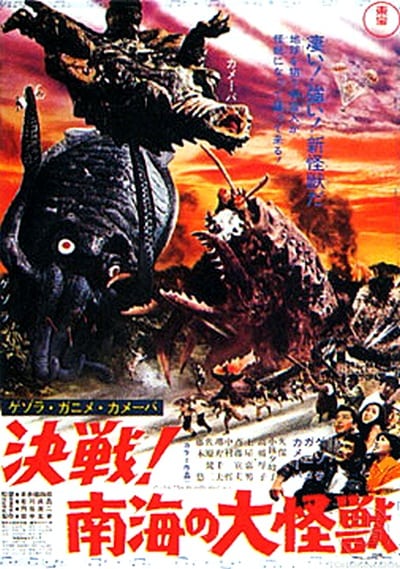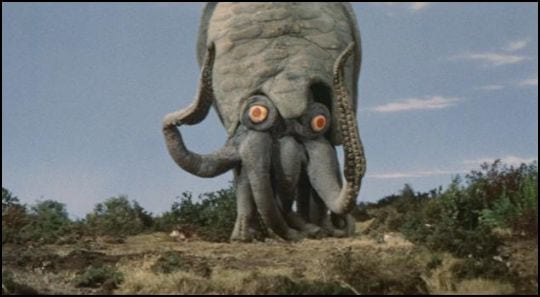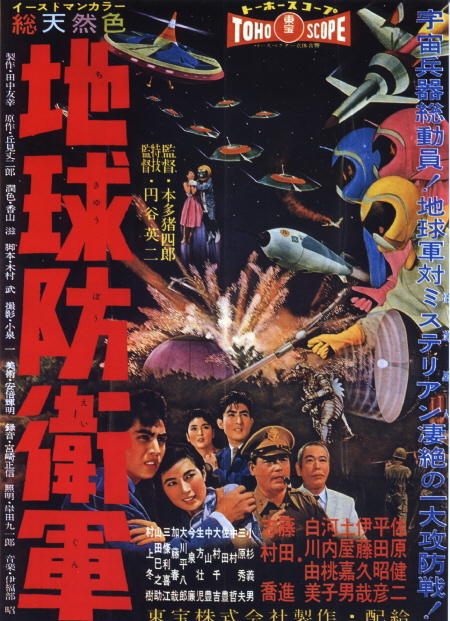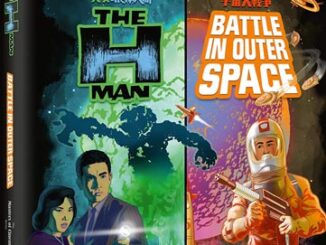Space Amoeba (1970)
Directed by: Ishirô Honda
Written by: Ei Ogawa
Starring: Akira Kubo, Atsuko Takahashi, Kenji Sahara, Yukiko Kobayashi
HCF REWIND NO. 138: SPACE AMOEBA AKA GEZORA GANIME KAMEBA KESSEN! NANKAI NO KAIJU, GEZORA GANIME KAMEBA DECISIVE BATTLE! GIANT MONSTERS OF THE SOUTH SEAS, YOG: MONSTER FROM SPACE [Japan, 1970]
AVAILABLE ON DVD
RUNNING TIME: 90 min
REVIEWED BY: Dr Lenera, Official HCF Critic
An unmanned space probe, Helios 7, is sent to explore Jupiter, but encounters a mysterious “cloud” which seeps into the probe and makes it reverse its course back to Earth. Photojournalist Taro Kudo catches a glimpse of Helios 7 falling towards the Pacific Ocean, but cannot convince his boss or anyone else of what he has seen. His new assignment is to take publicity photos on Selgio Island for some developers who want to build there. He discovers that that Selgio Island is located in the vicinity of where he saw Helios 7 go down. However, there are also legends of monsters on the island, and a large cuttlefish called Gezora appears to kill two people, something which the islanders blame on the visitors…..
Space Amoeba is a lot of fun, but it’s also a disjointed, aimless, unoriginal mess. I’ll happily defend much of Toho’s science-fiction output against claims that they are bad movies, because often it just isn’t so. Godzilla, Mothra, Battle In Outer Space, Matango, Mothra Vs Godzilla, Ghidorah The Three-Headed Monster; I’ll say till my dying day that they are very fine films. At the other end of the scale though we have films like Space Amoeba, which are good more for a laugh then anything else. This film does little more than rehash plot elements, situations and scenes from earlier films, mostly those directed by Ishiro Honda, on the same kind of island setting as Jun Fukuda’s two ’60’s Godzilla movies Godzilla Vs The Sea Monster and Son Of Godzilla. Despite all this, it’s never dull and always keeps moving. It’s just a shame that this was the last Toho monster film to feature much of the original crew. After this, it would be mainly new folk both behind and in front of the camera, and much of the magic would be gone.
Just before this film went into production, Toho’s special effects genius Eiji Tsuburaya died from pneumonia, and, even though in the second half of the ’60’s he was more of a supervisor than anything else and concentrated more on his TV shows, the quality of the effects work afterwards went down very quickly in the films. Space Amoeba, as was often becoming the case, was very much aimed at kids and had to make do with quite a low budget. The latter meant that certain mishaps were not corrected. For example the lit eyes of the giant cuttlefish Gezora went dead halfway through filming. There was no money left in the budget to repair them, so they remained unlit in certain scenes. The film was originally meant to be shot on location in Guam, but this was changed to Hachigo Island because Guam was too expensive. Newcomer Ei Ogawa wrote the script. Space Amoeba did average box office business and the following year saw a US release release from AIP as Yog: Monster From Space. As was now common, the alterations made were minimal, amounting to minor cuts and occasional shifting around of music, but sadly the original Hong Kong dubs [Frontier Enterprises was by now no more] were also now being kept and they were always very poor.
For this film, it seems like writer Ogawa just decided to piece together bits and pieces from other Honda films. A rocket launch at the beginning. Natives worshipping a monster god. A man possessed by aliens who at the end sacrifices himself to save the earth. Aliens possessing and controlling animals. Aliens sensitive to a certain sound. A man suffering from amnesia. Scuba divers examining a sunken capsule. A very obvious bad guy joining an expedition. A volcano destroying monsters. And so it goes on, the film a virtual catalogue of things, ranging from plot points to small details, that have been done before and often more than once. The script really is the film’s biggest problem, because when it isn’t copying, it just alternates between being lazy and just plain stupid. Our heroes work out that Gezora can be destroyed by gasoline, and guess what, there happens to be a load of the stuff right by the native village. The amnesiac fails to recognise his girlfriend, but the two are married before his memory returns. The second monster possessed by the aliens follows in the exact same footsteps as the first and is destroyed exactly the same way. There isn’t even any reason for the last two monsters to fight at the end, considering they are both possessed, except that by now such a battle was considered essential to a Toho monster movie.
The film does proceed at a headlong pace, rarely pausing for breath. The exposition is dealt with in a few short scenes and the first monster appears very quickly. After this, it’s basically people being chased around by monsters. There’s no attempt at fear or even tension; the monsters just pop up every now and again and then disappear. They don’t even cause much carnage besides knocking over a couple of huts and only visibly kill one person. A comparison of, for instance, Gezora’s attack on the native village with a similar scene in Varan The Unbelievable, really shows how limited the newer film is. They obviously intended to make the film very kid-friendly without actually seeming to be a kid’s film. The human drama doesn’t really work either. The whole sub-plot about Makoto Ogata, the shifty guy who turns out to be an industrial spy, is sloppily handled, especially when he confesses instantly and simply gives up the plans without a fuss, while his self-sacrifice at the end is handled with virtually no drama at all. Director Honda seems to enjoy the often pretty locations, but is generally content to move things along at top speed and not take the action to a higher level.
The effects by Teisho Arikawa range from okay to poor. Gezora the big cuttlefish looks incredibly rubbery and his tentacles change in size as the different shots are edited together, but the sight of him walking on land, the legs of the actor inside the costume very obvious as two tentacles end in what look like elf shoes, is truly a weird sight and does epitomise the free-wheeling nature of Japanese monster movies very well. Gezora is remarkably unscary though and the chirping noise he makes doesn’t help. The two monster crabs Ganimes, more complicated in design than the similar Ebirah but less menacing, and the huge turtle Kamoeba, who has a cool extending neck, are reasonably well done, but lack the personality of most of Toho’s monsters, while the battle between the second Ganime and Kamoeba is one of the dullest in Toho’s history. It’s as if Arikawa just wanted to get it over with as quickly as possible. Some atmospheric and effectively lit scenes inside a cave [cinematographer Yoichi Monoda does a great job all the way through] show signs of a much better film, and Space Amoeba is never boring; it’s just pedestrian, as if it was made because it had to be, rather than because the makers actually wanted to.
The cast, which includes the final major performances by Akira Kubo, Kenji Sahara and, for a very long time, Yoshio Tsuchiya, play their roles with conviction. Kubo effectively plays against type as the cynical, world-weary hero and Sahara does a good job in the role Tsuchiya would normally have played; the two actors swapped parts, Tsuchiya obviously tired of playing people possessed by aliens. Akira Ifikube’s score is loud and proud, constantly pounding away to try to enhance the film, though his three monster themes are unmemorable and you can hear the native chant from King Kong Vs Godzilla in some scenes, though otherwise he doesn’t self-borrow here. Overall, Space Amoeba is a fairly forgettable effort from Toho, and sometimes very poor indeed, yet it still has a likeable innocence that similar films today just don’t, or can’t, replicate.
Rating: 

















Be the first to comment